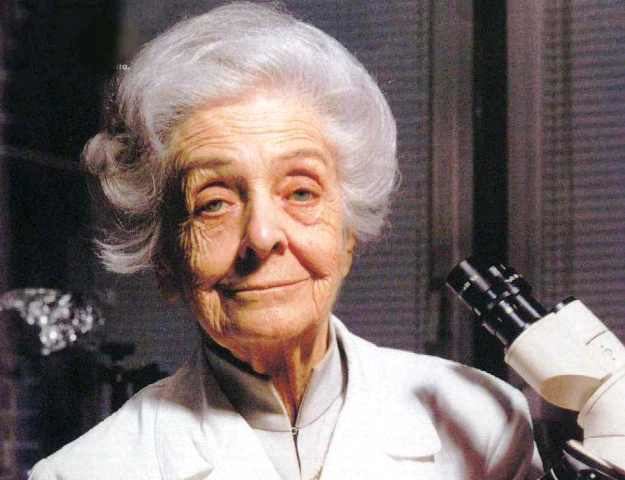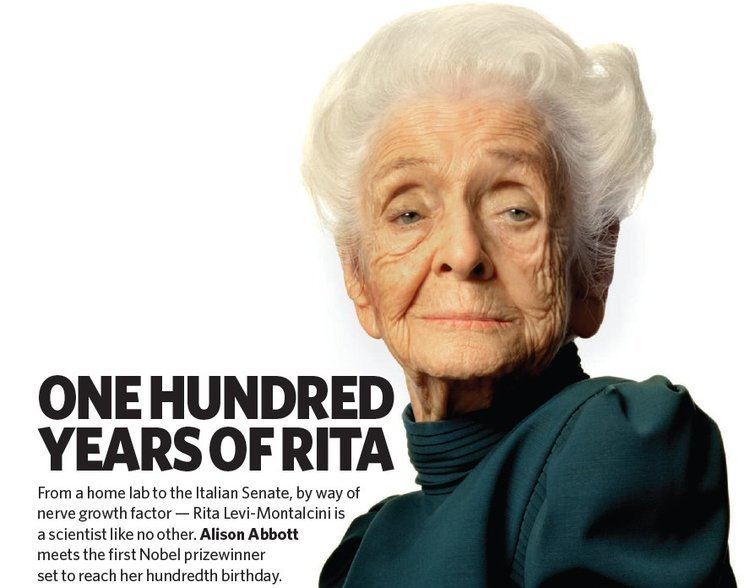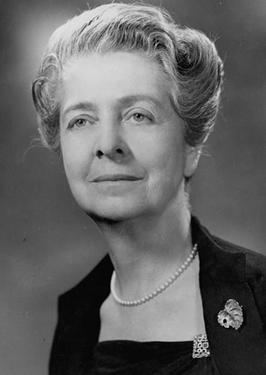Known for Nerve growth factor Nationality Italian Name Rita Levi-Montalcini | Fields Neurology | |
 | ||
Parents Adele Montalcini, Adamo Levi Siblings Paola Levi-Montalcini, Gino Levi-Montalcini, Anna Levi-Montalcini Books Elogio dell'imperfezione, Abbi il coraggio di conoscere, The saga of the nerve gro, In praise of imperfection, Elogio De La Imperfeccion Similar People | ||
Uomo scienziato: Rita Levi Montalcini
Rita Levi-Montalcini, ([ˈriːta ˈlɛːvi montalˈtʃiːni]; 22 April 1909 – 30 December 2012) was an Italian Nobel laureate, honored for her work in neurobiology. She was awarded the 1986 Nobel Prize in Physiology or Medicine jointly with colleague Stanley Cohen for the discovery of nerve growth factor (NGF). From 2001 until her death, she also served in the Italian Senate as a Senator for Life.
Contents
- Uomo scienziato Rita Levi Montalcini
- Rita levi montalcini 1986 nobel laureate in medicine a meditation
- Early life and education
- Career and research
- Political career
- Personal life
- Awards and honors
- References

On 22 April 2009, she became the first Nobel laureate ever to reach the age of 100, and the event was feted with a party at Rome's City Hall. At the time of her death, she was the oldest living Nobel laureate.

Rita levi montalcini 1986 nobel laureate in medicine a meditation
Early life and education

Levi-Montalcini was born on 22 April 1909 in Turin, to a Sephardic Jewish family She and her twin sister Paola were the youngest of four children. Her parents were Adele Montalcini, a painter, and Adamo Levi, an electrical engineer and mathematician, whose families had moved from Asti and Casale Monferrato, respectively, to Turin in the early twentieth century.

In her teenage years, she considered becoming a writer and admired Swedish writer Selma Lagerlöf, but after seeing a close family friend die of stomach cancer she decided to attend the University of Turin Medical School. Her father discouraged his daughters from attending college, as he feared it would disrupt their potential lives as wives and mothers, but eventually he supported Levi-Montalcini's aspirations to become a doctor. While at the University of Turin, the neurohistologist Giuseppe Levi sparked her interest in the developing nervous system. After graduating summa cum laude M.D. in 1936 she remained at the university as Levi's assistant, but her academic career was cut short by Benito Mussolini's 1938 Manifesto of Race and the subsequent introduction of laws barring Jews from academic and professional careers.
Career and research
Levi-Montalcini lost her assistant position in the anatomy department after a 1938 law barring Jews from university positions was passed. During World War II she set up a laboratory in her bedroom and studied the growth of nerve fibers in chicken embryos, which laid the groundwork for much of her later research. She described this experience decades later in the science documentary film Death by Design/The Life and Times of Life and Times (1997). The film also features her fraternal twin sister Paola, who became a respected artist. When the Germans invaded Italy in 1943, her family fled south to Florence, where she set up a second laboratory in a corner of their shared living space. During this time, she also volunteered her medical expertise for the Allied health service. Her family returned to Turin in 1945.
In September 1946, Levi-Montalcini was granted a one-semester research fellowship in the laboratory of Professor Viktor Hamburger at Washington University in St. Louis. After she duplicated the results of her home laboratory experiments, Hamburger offered her a research associate position, which she held for 30 years. It was there that, in 1952, she did her most important work: isolating nerve growth factor (NGF) from observations of certain cancerous tissues that cause extremely rapid growth of nerve cells. By transferring pieces of tumors to chick embryos, Montalcini established a mass of cells that was full of nerve fibers. The discovery of nerves growing everywhere like a halo around the tumor cells was surprising. When describing it, Montalcini said it is: "like rivulets of water flowing steadily over a bed of stones." The nerve growth produced by the tumor was unlike anything she had seen before – the nerves took over areas that would become other tissues and even entered veins in the embryo. But nerves did not grow into the arteries, which would flow from the embryo back to the tumor. This suggested to Montalcini that the tumor itself was releasing a substance that was stimulating the growth of nerves.
She was made a full professor in 1958. In 1962, she established a second laboratory in Rome and divided her time between there and St. Louis.
From 1961 to 1969, she directed the Research Center of Neurobiology of the CNR (Rome), and from 1969 to 1978, the Laboratory of Cellular Biology. After she retired in 1977, she was appointed as director of the Institute of Cell Biology of the Italian National Council of Research in Rome. She later retired from that position in 1979, however continued to be involved as a guest professor.
Levi-Montalcini founded the European Brain Research Institute in 2002, and then served as its president. Her role in this institute was at the center of some criticism from some parts of the scientific community in 2010.
Controversies were raised about the cooperation of Levi-Montalcini with the Italian pharmaceutical industry Fidia . While working for Fidia, she improved the understanding of gangliosides. Beginning in 1975, the scientist supported the drug Cronassial (a particular ganglioside) produced by Fidia from bovine brain tissue. Independent studies showed that the drug actually could be successful in treatment of intended diseases (periphrastic nervous system neuropathies). Years later, some patients under treatment with Cronassial reported a severe neurological syndrome (Guillain–Barré syndrome). As per the normal cautionary routine, Germany banned Cronassial in 1983, followed by other countries. Italy prohibited the drug only in 1993; at the same time, an investigation revealed that Fidia paid the Italian Ministry of Health for a quick approval of Cronassial and later paid for pushing use of the drug in treatment of diseases where it had not been tested. Levi-Montalcini's relationship with the company was revealed during the investigation, and she was criticized publicly.
In the 1990s, she was one of the first scientists pointing out the importance of the mast cell in human pathology. In the same period (1993), she identified the endogenous compound palmitoylethanolamide as an important modulator of this cell.
Political career
On 1 August 2001, she was appointed as Senator for Life by the President of Italy, Carlo Azeglio Ciampi.
On 28–29 April 2006, Levi-Montalcini, aged 97, attended the opening assembly of the newly elected Senate, at which the President of the Senate was elected. She declared her preference for the centre-left candidate Franco Marini. Due to her support of the government of Romano Prodi, she was often criticized by some right-wing senators, who accused her of "saving" the government when the government's exiguous majority in the Senate was at risk. She was insulted by politician Francesco Storace.
Personal life
Levi-Montalcini had an older brother Gino, who died after a heart attack in 1974. He was one of the most well known Italian architects and a professor at the University of Turin. She had two sisters: Anna, five years older than Rita, and Paola, her twin sister, a popular artist who died on 29 September 2000, age 91.
Levi-Montalcini never married and had no children. In a 2006 interview she said: "I never had any hesitation or regrets in this sense... My life has been enriched by excellent human relations, work and interests. I have never felt lonely." She died in her home in Rome on 30 December 2012 at the age of 103.
Upon her death, the Mayor of Rome, Gianni Alemanno, stated it was a great loss "for all of humanity." He praised her as someone who represented "civic conscience, culture and the spirit of research of our time." Italian astrophysicist Margherita Hack told Sky TG24 TV in a tribute to her fellow scientist, "She is really someone to be admired." Italy's premier, Mario Monti, paid tribute to Levi-Montalcini's "charismatic and tenacious" character and for her lifelong endeavor to "defend the battles in which she believed." Vatican spokesman Federico Lombardi praised Levi-Montalcini's civil and moral efforts, saying she was an "inspiring" example for Italy and the world.
Awards and honors
In 1966, she was elected a Fellow of the American Academy of Arts and Sciences.
In 1968, she became the tenth woman elected to the United States National Academy of Sciences. She was elected an EMBO Member in 1974.
In 1974, although a professed atheist, she became a member of the Pontifical Academy of Sciences
In 1983, she was awarded the Louisa Gross Horwitz Prize from Columbia University.
In 1986, Levi-Montalcini and collaborator Stanley Cohen received the Nobel Prize in Medicine, as well as the Albert Lasker Award for Basic Medical Research. This made her the fourth Nobel Prize winner to come from Italy's small (less than 50,000 people) but very old Jewish community, after Emilio Segrè, Salvador Luria (a university colleague and friend) and Franco Modigliani.
In 1987, she received the National Medal of Science, the highest American scientific honor.
In 1991, she received the Laurea Honoris Causa in Medicine from the University of Trieste, Italy. On that occasion, she expressed her desire to formulate a Carta of Human Duties as necessary counterpart of the too much neglected Declaration of Human Rights. The vision of Rita Levi-Montalcini came true with the issuing of the Trieste Declaration of Human Duties and the foundation in 1993 of the International Council of Human Duties, International Council of Human Duties (ICHD), at the University of Trieste.
She was elected a Foreign Member of the Royal Society (ForMemRS) in 1995.
In 1999, Levi-Montalcini was nominated Goodwill Ambassador of the United Nations Food and Agriculture Organization (FAO) by FAO Director-General Jacques Diouf.
In 2001, she was nominated Senator-for-life by the Italian President Carlo Azeglio Ciampi.
In 2006, Levi-Montalcini received the degree Honoris Causa in Biomedical Engineering from the Polytechnic University of Turin, in her native city.
In 2008, she received the PhD Honoris Causa from the Complutense University of Madrid, Spain.
She was a founding member of Città della Scienza. and Accademician of Studium, Accademia di Casale e del Monferrato, Italy.
